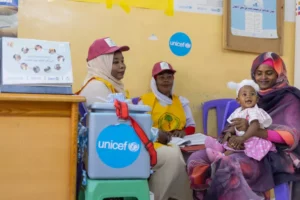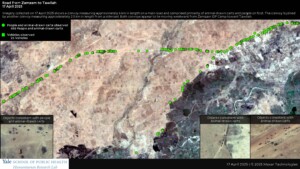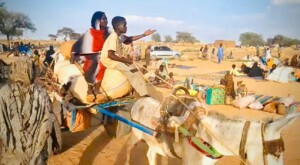South Sudan to resettle 70,000 Nuba refugees
The more than 70,000 residents of the South Sudanese Yida refugee camp, near the Sudan-South Sudan border, will be resettled in June next year. However, the location of the alternative camps is less secure, says Nuba Reports
The more than 70,000 residents of the South Sudanese Yida refugee camp, near the Sudan-South Sudan border, will be resettled in June next year. However, the location of the alternative camps is less secure, Nuba Reports stated on 18 December.
During a recent consultative meeting between the UN’s Refugee Agency (UNHCR) and Yida camp elders, UNHCR delegate Nigora Kadirhojaeva told the refugees that the camp would be closed in mid-June.
El Nur Salih, Chairman of the Yida Refugee Council who attended the meeting said that until then only select vulnerable groups such as the elderly and disabled would receive limited, non-food supplies such as mosquito nets and plastic sheeting.
The UNHCR and the South Sudanese Refugee Affairs Commission are already pushing Yida residents to resettle in the Ajuong Thok refugee camp and another proposed camp called Pamir, where food rations and other services are provided.
The registration of new arrivals to Yida continues, UNHCR South Sudan Representative Juliette Stevenson told Nuba Reports. Yet, since 2013 food rations are provided to newcomers only if they relocate to Ajuong Thok camp.
The UNHCR cited concerns of overpopulation in Yida as one of the reasons for the resettlement. Its former head of operations in Unity State, Marie-Helene Verney, voiced their concerns of potentially having 100,000 refugees in one place. “We know what that means from other countries, we know the problems of health, with availability of water, with security problems that come with that [overpopulation] and we fear the same for Yida too.”
‘Not an official camp’
Yida, a settlement in South Sudan’s Unity state, hosted about 20,000 refugees from South Kordofan end 2011, after war broke out between the Sudan People’s Liberation Movement-North (SPLM-N) in June.
UNHCR and the South Sudanese government say Yida has never been officially recognised as refugee camp and never can be, despite the 70,166 refugees registered there. This is for two main reasons, says Rocco Nuri, Public Information/Communications Officer at UNHCR: the camp’s proximity to the Sudan-South Sudan border, and “armed elements” in the camp.
The Yida camp lies 14 kilometres from the Sudan-South Sudan border, which is less than the 50-kilometres-minimum set by UN guidelines. Ajuong Thok is just two kilometres further away from the border and according to a UNHCR map, Pamir lies a similar distance from the border.
Yida residents say that the negligible difference in the distance between the camps not only fails to meet the UN guidelines, but that the location of the alternative camps is less secure.
Ajuong Thok is only 45 kilometres away from a Sudanese army base, Ismail Hussein, Deputy Chairman of the Yida Refugee Council said. “Those are the very people the Yida refugees fled from in the first place.
“The future Pamir camp is located in an area with several nomadic tribes who are in conflict with Yida residents,” he added. “You find [there] people and tribes who kicked us out of our homeland in the Nuba Mountains,” Hussein said. “It is also [in an area] controlled by South Sudanese rebel forces so it is not safe and not in the hands of the government of South Sudan. These two reasons scared [the people] to move to Pamir.”
Several Yida residents told Nuba Reports that in comparison Yida provides an escape route that they think is safer to make their way home should they want to.
UNHCR, however, claims there are armed elements operating in Yida camp making it unsafe for refugees or humanitarians to operate there. According to Stevenson, Yida is too close to a border that is in dispute between Sudan and South Sudan and its militarisation by armed groups compromises its suitability as a refugee site.
Refugee Chairman Salih, however, disputes this claim. Salih concedes that armed groups from Darfur, western Sudan, were present in Yida camp in the past but claims the South Sudan army forced the armed groups to leave the camp.
‘Resources better in Yida’
A dispute over the resources available for refugees in Yida as opposed to Ajuong Thok also persists. Based on UNHCR data, water accessibility is better in Yida but malnutrition and child mortality rates remain lower in Ajuong Thok.
Several Yida residents told Nuba Reports however that Ajuong Thok residents are returning to Yida because of the limited food rations at Ajuong Thok and the refugees cannot farm outside this camp to make ends meet.
The key difference for the Nuba refugees between the two camps concerns self-reliance: the host community allows Yida residents to farm and set up markets while those in Ajuong Thok do not, Salih explained.
Farming is increasingly important for the refugees to have enough to eat as the World Food Programme (WFP) struggles with funding and cuts food rations. Funding shortfalls have forced WFP to reduce rations for refugees in South Sudan by 30 percent since August.
‘Struggle again’
As it stands, many in Yida remain in a state of limbo –unsure whether they can continue harvesting and building or whether they must pack up once more for another settlement. “We as Nuba flourished in this place, each has their own work, some are farming and traders started their business,” said El Kheir Mojid, a Yida refugee and trader.
“And now when the UN asked us to move, it will make us struggle again.”











 and then
and then